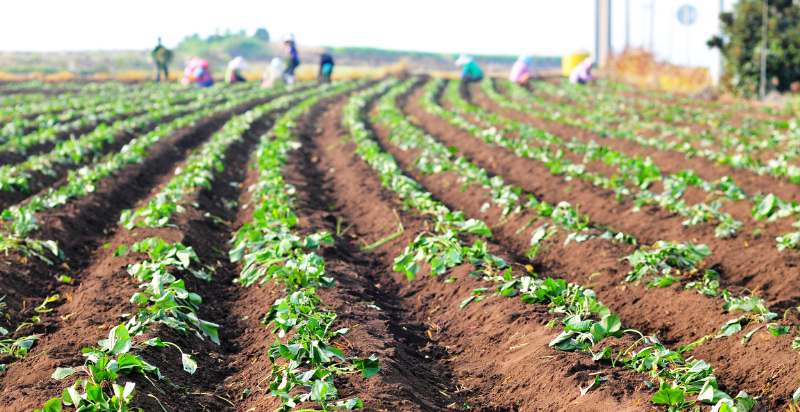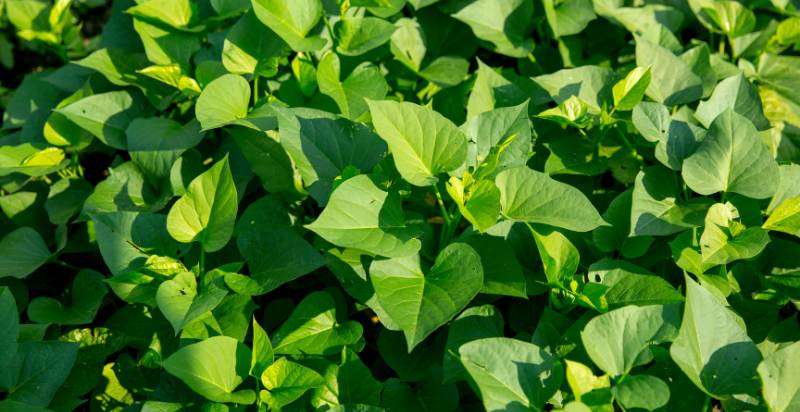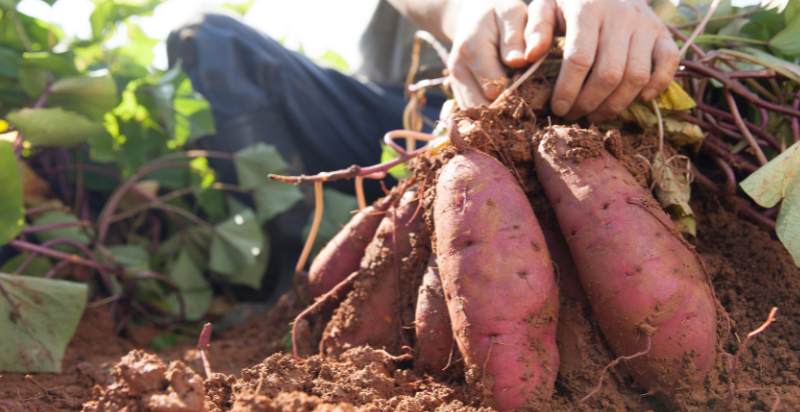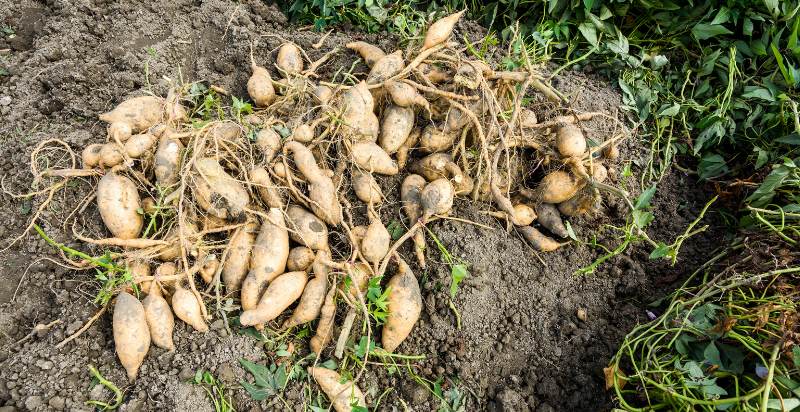Sweet potatoes have carved out a special place in gardens and kitchens around the world, and it’s easy to see why. These vibrant tubers are not just a feast for the eyes with their rich colors, but they’re also packed with nutritional goodness. Loaded with vitamins A and C, they’re champions for your immune system and vision. Plus, their high fiber content makes them great for digestion. What’s more, sweet potatoes are incredibly versatile in the kitchen.
Whether baked, roasted, or turned into comforting soups and stews, they bring a natural sweetness that enhances any dish. And let’s not forget about their leaves, which are edible and nutritious too! As someone who enjoys growing and cooking with them, I’ve found sweet potatoes to be a rewarding addition to my garden and my plate. They’re not just food; they’re a colorful, healthy, and delicious adventure.
History and Origin
Sweet potatoes (Ipomoea batatas) are a type of root vegetable native to Central and South America. They have been cultivated for thousands of years and have become an important food crop in many parts of the world. Sweet potatoes come in various shapes, sizes, and colors, including white, yellow, and orange-fleshed varieties, often with a light, sweet flavor.
The sweet potato has been an important food source for many cultures throughout history. It is thought to have originated in Central or South America and was then spread by ancient Polynesians, who introduced the root vegetable to other parts of the world. The earliest evidence of its cultivation dates back around 8,000 years ago.

Choosing Your Sweet Potato Plants
Choosing the right start for your sweet potato plants is like setting the foundation for a bountiful harvest. Whether you’re drawn to the ease of slips, the adventure of seeds, or the DIY spirit of vine cuttings, there’s a method that suits your gardening style.
Finding Your Plants
Starting your sweet potato journey begins with finding the right plants. Whether you’re browsing your local garden center or searching online, there’s a variety of sweet potato plants available for sale. It’s exciting to see all the options, from those perfect for baking to varieties that are ideal for soups and stews.
Sweet Potato Varieties
When it comes to sweet potatoes, the variety really does make a difference. There are two main types of sweet potatoes, moist and dry. Moist varieties have a higher water content and are usually sweeter than the dry type. They are also softer and easier to cook. Dry varieties tend to be starchier and have fluffier flesh when cooked. Some common types of sweet potatoes include Beauregard, Jewell, Red Garnet, and Japanese varieties.
Take the Beauregard, for example, a popular choice known for its great taste and high yields. But that’s just the tip of the iceberg. There are so many varieties to explore, each with its own unique flavor, texture, and growth habits. It’s like a treasure hunt, finding the one that will thrive in your garden and delight your taste buds.
Seeds, Slips, or Vine Cuttings?
Now, here’s where it gets interesting. You can start your sweet potato plants from seeds, slips (young plants sprouted from a mature sweet potato), or vine cuttings. Each method has its own charm. Seeds can be a bit challenging but rewarding for those who love a gardening challenge. Slips are the most common and easiest way to start, giving you a head start on the growing season. And vine cuttings? They’re perfect for those who want to experiment and see the magic of sweet potato vines turning into lush plants.
Nutritional Value
Sweet potatoes are an excellent source of vitamins, minerals, and nutrients. They contain more than twice the amount of vitamin A as regular potatoes and are rich in dietary fiber. They also provide substantial amounts of vitamin C, manganese, copper, pantothenic acid, vitamin B6, potassium, and iron. Sweet potatoes also contain phytonutrients that have health-promoting properties. In addition, they are low in calories and fat making them a good choice for anyone looking to maintain a healthy diet.
Eating sweet potatoes can help reduce inflammation due to their high levels of antioxidants, such as beta-carotene and zeaxanthin, which helps protect against free radical damage from environmental toxins. Sweet potatoes are also packed with complex carbohydrates, which help provide a steady supply of energy and can aid in weight management.
Sweet potatoes are also beneficial to digestion due to their high fiber content which helps to reduce constipation and promote regularity. Overall, sweet potatoes are an incredibly nutritious food that should be included in any balanced diet.
How to Plant Sweet Potatoes
Sweet potatoes are an easy and delicious vegetable to grow in your garden. With the right preparation, soil, and location, you can have a bountiful harvest of sweet potatoes that you can enjoy for months! Here’s what you need to know about how to plant sweet potatoes.
Soil Preparation:
When planting sweet potatoes, it’s important to ensure the soil is well-prepared. The soil should be loose and free from any weeds or debris that could interfere with growth. A good way to prepare the soil is by adding composted manure or other organic materials to help improve drainage and provide essential nutrients for your plants.
Location Selection:
The location of your sweet potato plot is also important. Sweet potatoes prefer warm and humid climates, so avoid planting them in areas with cold winters or dry summers. If you live in an area with a longer growing season, you can plant your sweet potatoes earlier than normal and get an even larger harvest.
Spacing:
Sweet potatoes require a fair amount of space to grow due to their sprawling vines. Ideally, each plant should have about 12 to 18 inches of space on all sides. This allows the vines to spread out and the tubers to expand and grow without being crowded. If you’re planting in rows, keep the rows at least 3 feet apart to give the plants plenty of room to flourish.
Planting:
When planting sweet potatoes, it’s best to wait until the soil temperature is consistently above 60°F (15°C). Planting too early can result in slower growth and fewer yields. Sweet potato slips are easy to find at most garden centers, but if you’re feeling adventurous, you can also propagate your own from tubers purchased online or at a local grocery store.

Care & Maintenance:
Sweet potatoes need regular watering during the growing season. Aim to water your plants every other day when they’re young and increase the amount as they mature. Make sure not to overwater, as too much water can affect the quality of the tubers. Fertilizer is also beneficial for sweet potatoes – choose one with a balanced nitrogen, phosphorus, and potassium ratio for best results.
Sweet potatoes are ready to be harvested approximately 3-4 months after planting. You’ll know it’s time to harvest when the foliage begins to yellow and die back. To harvest your sweet potatoes, gently dig around the base of each plant with a spade or garden fork until you reach the roots. Remove any dirt from their surface before storing it in a dry, dark place. They should keep for several months if stored properly.
Growing sweet potatoes is a fun and rewarding experience, and with the right preparation, you can enjoy an abundant harvest of delicious tubers. With proper soil preparation, location selection, and regular care and maintenance, you’ll be harvesting plenty of sweet potatoes for your family to enjoy.
Steps to Care for Sweet Potatoes
Sweet potatoes are easy to care for but require regular maintenance. Here are a few tips on how to care for sweet potatoes:
- Ensure proper drainage. Sweet potatoes prefer well-draining soil, so make sure your garden beds have adequate drainage and consider using raised beds if necessary.
- Apply fertilizer regularly. To ensure healthy growth and large yields, apply a balanced fertilizer once every two weeks during the growing season.
- Water properly. Sweet potatoes need about one inch of water per week during the growing season, but avoid over-watering as too much can lead to root rot or other problems.
- Protect from pests & disease. Keep an eye out for common pests such as aphids, corn earworms, and potato beetles. If you find any pests or signs of disease, use organic methods to control them.
- Harvest at the right time. Sweet potatoes are usually ready for harvest 3-4 months after planting. Keep an eye on the foliage – once it begins to yellow and die back, it’s time to harvest your sweet potatoes!
Follow these tips, and you’ll surely have a successful crop of delicious sweet potatoes!

Preventions from Pests and Diseases
Despite the benefits of sweet potatoes, they are susceptible to pests and diseases that can reduce your yields. To prevent these issues, you should:
- Regularly inspect plants for signs of pests or disease.
- Utilize natural pest control methods such as insecticidal soaps, neem oil, or beneficial insects like ladybugs and lacewings.
- Rotate crops in your garden beds each year to prevent soil-borne diseases from building up in the soil.
- Plant disease-resistant varieties whenever possible. These varieties have been bred specifically to be more resistant to common plant diseases.
- Cover vulnerable areas with row covers or netting to protect them from birds and other pests.
- Mulch around your plants to help conserve moisture and reduce weed growth.
- Dispose of any diseased plants and debris immediately to prevent the spread of disease.
Following these steps ensures that your sweet potatoes remain healthy and productive throughout the growing season.

How to Harvest Sweet Potatoes
Sweet potatoes are ready for harvest 3-4 months after planting. To determine if they are ready, check the foliage – when it starts to yellow and die back, your sweet potatoes will be ripe and ready for harvesting.
To harvest, gently dig around the base of each plant with a spade or garden fork until you reach the roots. Then carefully remove any dirt from the surface of your sweet potatoes before storing them in a dry, dark place. They should keep for several months if stored properly.
Harvesting sweet potatoes can be messy, so wear gloves and long sleeves to protect against scratches and dirt. With these tips in mind, you’ll easily gather plenty of sweet potatoes for your family to enjoy.
To get the most out of your crop, it’s important to follow these steps and care for your sweet potatoes properly. With regular maintenance and the right soil preparation, you can ensure that you have a healthy and abundant harvest of sweet potatoes every year.

After the Harvest
Once you’ve harvested your sweet potatoes, you may have questions such as regrowing the plant and storing the plant. I will answer these questions in this section.
Do Sweet Potatoes Regrow
Well, the beauty of sweet potato plants is in their ability to give more than just one harvest. If left in the ground, the vines can sprout new plants, continuing the cycle. However, for a more controlled regrowth, saving a few sweet potatoes to plant as slips for the next season is the way to go. It’s like the plant’s gift that keeps on giving, ensuring you have a steady supply of sweet potatoes year after year.
How to Store Sweet Homegrown Potatoes
Once your sweet potatoes are harvested, the next step is properly storing them, so they last as long as possible. Here are some tips for storing homegrown sweet potatoes:
- Choose only healthy potatoes – any that have bruises or cuts should be eaten immediately instead of stored.
- Cure the potatoes before storing – this means leaving them in a warm (but not hot) place for about two weeks to develop their skins.
- Store in a cool, dark location with plenty of ventilation. A basement or root cellar is ideal if you have one available.
- Pack in paper bags or cardboard boxes and avoid plastic containers, which can trap moisture and cause rot.
- Check regularly and remove any potatoes that show signs of spoilage.
By following these steps, you’ll be able to keep your sweet potatoes fresh and delicious for months!
How to Prepare Sweet Potatoes
Once you’ve harvested and stored your sweet potatoes, it’s time to get cooking! Here are some tips on how to prepare them:
- Sweet potatoes can be baked, boiled, steamed, grilled, or mashed into a creamy mash.
- Cut in half lengthwise before baking to reduce cooking time and make sure they cook evenly.
- For a lightly crunchy texture, fry sweet potato cubes in hot oil until golden brown.
- Add flavor with spices like cinnamon, nutmeg, allspice, or cumin.
- Roast sweet potato cubes with garlic and rosemary for a flavor-packed side dish.
With so many delicious ways to prepare sweet potatoes, there’s no shortage of recipes to try! Experimenting with different flavors and textures is half the fun, so get creative in the kitchen and enjoy your homegrown harvest. And don’t forget – sweet potatoes are also full of vitamins and minerals, making them an incredibly nutritious food choice for your family.

How to Use Sweet Potatoes in Different Dishes
Sweet potatoes have long been known as nutritious and versatile root vegetables. This hearty tuber is packed with fiber, vitamins, minerals, and antioxidants that support good health. Sweet potatoes can be used in many dishes, including soups, salads, casseroles, bread, muffins, cakes, and pies. They also make a great side dish for meats or fish. Read on to learn more about using sweet potatoes in your favorite recipes!
Soups
One of the most popular ways to enjoy sweet potatoes is in soup form. To make a simple sweet potato soup:
- Start by sautéing onions and garlic in butter until lightly browned.
- Add cubed sweet potatoes along with chicken broth and bring to a boil.
- Simmer for about 20 minutes or until the sweet potatoes are soft.
- Puree the soup and season with salt and pepper to taste.
- Try adding some heavy cream or coconut milk for a creamier version of this soup.
Salads
Sweet potatoes make a great addition to salads since their natural sweetness gives them a unique flavor profile that pairs well with many other ingredients.
To prepare sweet potato salad, start by roasting cubes of peeled sweet potatoes in olive oil at 350°F for about 30 minutes or until tender. Meanwhile, cook bacon until crispy and set aside.
In a large bowl, combine cooked sweet potatoes, cooked bacon, chopped red onion, diced bell peppers, feta cheese crumbles, and some fresh parsley.
Whisk together a simple dressing of equal parts olive oil, lemon juice or vinegar, and honey. Drizzle the dressing over the salad and season with salt and pepper to taste.
Casseroles
Sweet potatoes are also ideal for casseroles because they can easily adapt to almost any flavor profile. To make a classic sweet potato casserole, preheat the oven to 375°F and grease an 8×8 baking dish. Layer peeled and cubed sweet potatoes at the bottom of the dish, followed by a layer of cooked spinach or kale. Top with a mixture of melted butter, brown sugar, cinnamon, nutmeg, and flour, forming a crunchy topping once baked. Bake for 30 minutes or until the topping is golden brown and bubbling.
Breads & Muffins
Sweet potatoes can also make a delicious sweet and savory bread, muffins, and even pancakes. To make a simple sweet potato muffin:
- Combine mashed sweet potato with melted butter in a large bowl.
- Mix together dry ingredients such as flour, baking powder, cinnamon, nutmeg, salt, and sugar in another bowl.
- Slowly add the dry ingredients to the wet ingredients until everything is combined.
- Divide the batter into lined muffin tins and bake at 350°F for 15-20 minutes or until a toothpick inserted into the center of the muffin comes out clean.
Cakes & Pies
Sweet potatoes can also be used to make delicious cakes and pies. To make a sweet potato pie, preheat the oven to 350°F and grease a 9-inch pie pan. Combine mashed sweet potatoes with melted butter, light brown sugar, cinnamon, nutmeg, salt, and a half in a large bowl. Pour the mixture into the prepared pie pan and bake for 40-45 minutes or until golden brown on top. Allow cooling before serving.
Sweet potatoes are an incredibly versatile ingredient that can be used in so many delicious dishes! The possibilities are endless, from soups to salads to casseroles to bread, muffins, cakes, and pies.
Potential Risks from Sweet Potatoes
While sweet potatoes are a nutritious and healthful food option, it is important to note that if eaten in large amounts, there can be potential risks. Sweet potatoes contain oxalates, which can form crystals in the body and cause kidney stones in some individuals. Additionally, people with diabetes should monitor their consumption of sweet potatoes as they can affect blood sugar levels. It is important to consult your doctor or healthcare provider before consuming them in large quantities.
It is also important to note that raw sweet potatoes may contain toxins and should not be consumed. The toxins can interfere with digestion, so ensure the sweet potatoes you eat are properly cooked before consumption.
Finally, always wash your sweet potatoes thoroughly before cooking to make sure any bacteria on the surface is removed.
Conclusion
Sweet potatoes are a nutritious and delicious food that can be incorporated into many different dishes. While there may be potential risks associated with eating them, they can be enjoyed safely by monitoring portion sizes and following proper cooking instructions. With creativity, you can use sweet potatoes to make all kinds of flavorful meals your whole family will love. Enjoy!
Frequently Asked Questions
How many sweet potatoes will a plant produce?
A single sweet potato plant can produce anywhere from 3 to 5 pounds of sweet potatoes under ideal conditions. The yield can vary based on factors like the variety of sweet potato, soil quality, and how well the plant is cared for. It’s always a pleasant surprise to dig up the soil at the end of the season and discover the bounty waiting beneath.
How long do sweet potatoes take to grow?
Sweet potatoes typically take about 90 to 120 days to mature, depending on the variety. They’re a bit of a waiting game compared to some other vegetables, but the wait is well worth it. The key is to plant them at the right time, so they have enough warm days to grow big and sweet.
Is sweet potato a good indoor plant?
While sweet potatoes are traditionally grown outdoors, you can grow them indoors with some care. They need a large pot and plenty of sunlight to thrive, so a sunny spot is crucial. Growing them indoors can be a fun project, especially if you start with a sweet potato slip in water and transplant it into soil as it begins to grow. Just remember, the indoor environment might limit the size of your harvest, but it’s definitely possible to grow them inside.
- Everything You Wanted to Know About Red Tamarillos - June 2, 2025
- A Guide to Tulips: Everything You Need to Know & More… - June 2, 2025
- Guanabana: Description, Flavor, Benefits, And Uses - May 27, 2025

16 thoughts on “How to Plant, Grow, and Harvest Sweet Potatoes”
Comments are closed.